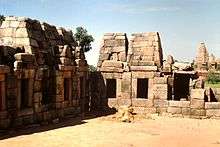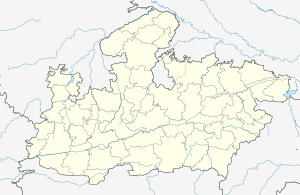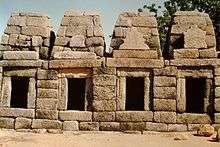Chausath Yogini temple, Khajuraho
The Chausath Yogini temple is a ruined Devi temple in the Khajuraho town of Madhya Pradesh, India. Dated to the late 9th century, it is the oldest surviving temple at Khajuraho. Unlike the Chausath Yogini temples at other places, it has a rectangular plan.
| Chausath Yogini temple | |
|---|---|
चौसठ योगिनी मन्दिर | |
 | |
| Religion | |
| Affiliation | Shaktism |
| District | Chhatarpur |
| Deity | Devi |
| Location | |
| Location | Khajuraho |
| State | Madhya Pradesh |
| Country | India |
 Location in Madhya Pradesh, India  Chausath Yogini temple, Khajuraho (India) | |
| Geographic coordinates | 24.8495199°N 79.9181333°E |
| Architecture | |
| Date established | 9th century CE |
History
The construction of the Chausath Yogini temple can be dated to approximately 885 CE.[1] It is the earliest extant temple at the Chandela capital Khajuraho.[2] The temple has been classified as a Monument of National Importance by the Archaeological Survey of India.[3]
Ruins of Yogini temples have also been found at other places in and around the territory formerly ruled by the Chandelas or their feudatories, including Badoh, Bhedaghat Dudahi, Lokhari, Hinglajgarh, Mitaoli, Naresar, and Rikhiyan. This suggests that the cult of the Yoginis was well-established in the Chandela territory. The Chausath Yogini temples are connected to the Kapalika and Kaula sects.[4]
Architecture

The temple is located among the Western group of temples on a 5.4 m high platform.[5] It has a rectangular plan measuring 31.4 m x 18.3 m.[5][2] Fourteen other historic Chausath Yogini temples have been discovered throughout India: the Khajuraho temple is the only one with a rectangular plan, all others have a circular plan.[6]
The temple is made of large, coarse granite blocks, with an open courtyard at the centre. The courtyard was originally surrounded by 65 shrine cells: 10 on the front (north) wall, 11 on the back wall, and 22 on each side. Only 35 of these 65 cells now survive.[2] Each cell has a small doorway and a curvilinear tower.[5]
With the exception of a large cell, each cell is approximately 1 m high and 1 m deep. The large cell is located at the centre of the back wall, and faces the entrance at the north. It was probably a shrine of Durga. The other 64 ("Chausath") cells presumably housed the statues of yoginis.[2]
Sculpture
The temple ruins have no sculpture. Three large statues of goddesses, found among the ruins, are now located at the Khajuraho museum.[2] The goddess have been identified as Brahmani, Maheshvari, and Hingalaja or Mahishamardini. These statues are among the oldest sculptures of Khajuraho.[5]
References
- Rana P. B. Singh 2009, p. 58.
- Ali Javid & Tabassum Javeed 2008, p. 201.
- ASI MP List 2016.
- Manohar Laxman Varadpande 1987, p. 291.
- ASI Bhopal Chausath 2016.
- Shobita Punja 2010, p. 39.
Bibliography
- Ali Javid; Tabassum Javeed (2008). World Heritage Monuments and Related Edifices in India. Algora. ISBN 978-0-87586-482-2.CS1 maint: ref=harv (link)
- "Chausath Yogini Temple". Archaeological Survey of India, Bhopal Circle. Retrieved 16 November 2016.
- "Alphabetical List of Monuments - Madhya Pradesh". Archaeological Survey of India, Bhopal Circle. Archived from the original on 2 November 2016. Retrieved 16 November 2016.
- Manohar Laxman Varadpande (1987). History of Indian Theatre: Classical theatre. Abhinav. ISBN 978-81-7017-430-1.CS1 maint: ref=harv (link)
- Rana P. B. Singh (2009). Cosmic Order and Cultural Astronomy. Cambridge Scholars. ISBN 9781443816076.CS1 maint: ref=harv (link)
- Shobita Punja (14 October 2010). Khajuraho: The First Thousand Years. Penguin. ISBN 978-93-85890-40-6.CS1 maint: ref=harv (link)